A Dual Source Switched-Capacitor Multilevel Inverter with Reduced Device Count
Abstract
:1. Introduction
2. Proposed Topology
3. Comparative Assessment
4. Power Loss Analysis
5. Results and Discussion
5.1. Simulation Results
5.2. Experimental Verification
6. Conclusions
Author Contributions
Funding
Acknowledgments
Conflicts of Interest
References
- Bhukya, M.N.; Kota, V.R.; Depuru, S.R. A Simple, Efficient, and Novel Standalone Photovoltaic Inverter Configuration with Reduced Harmonic Distortion. IEEE Access 2019, 7, 43831–43845. [Google Scholar] [CrossRef]
- Dhanamjayulu, C.; Khasim, S.R.; Padmanaban, S.; Arunkumar, G.; Holm-Nielsen, J.B.; Blaabjerg, F. Design and Implementation of Multilevel Inverters for Fuel Cell Energy Conversion System. IEEE Access 2020, 8, 183690–183707. [Google Scholar] [CrossRef]
- Chen, J.; Song, Q.; Yin, S.; Chen, J. On the Decentralized Energy Management Strategy for the All-Electric APU of Future More Electric Aircraft Composed of Multiple Fuel Cells and Supercapacitors. IEEE Trans. Ind. Electron. 2020, 67, 6183–6194. [Google Scholar] [CrossRef]
- Celanovic, N.; Boroyevich, D. A comprehensive study of neutral-point voltage balancing problem in three-level neutral-point-clamped voltage source PWM inverters. IEEE Trans. Power Electron. 2000, 15, 242–249. [Google Scholar] [CrossRef]
- Cao, W.; Mecrow, B.C.; Atkinson, G.J.; Bennett, J.W.; Atkinson, D.J. Overview of electric motor technologies used for more electric aircraft (MEA). IEEE Trans. Ind. Electron. 2012, 59, 3523–3531. [Google Scholar]
- Pradeep Kumar, V.V.S.; Fernandes, B.G. A Fault-Tolerant Single-Phase Grid-Connected Inverter Topology with Enhanced Reliability for Solar PV Applications. IEEE J. Emerg. Sel. Top. Power Electron. 2017, 5, 1254–1262. [Google Scholar] [CrossRef]
- Sarwar, M.I.; Sarwar, A.; Farooqui, S.A.; Tariq, M.; Fahad, M.; Beig, A.R.; Alamri, B. A Hybrid Nearest Level Combined with PWM Control Strategy: Analysis and Implementation on Cascaded H-Bridge Multilevel Inverter and its Fault Tolerant Topology. IEEE Access 2021, 9, 44266–44282. [Google Scholar] [CrossRef]
- Rodríguez, J.; Bernet, S.; Wu, B.; Pontt, J.O.; Kouro, S. Multilevel voltage-source-converter topologies for industrial medium-voltage drives. IEEE Trans. Ind. Electron. 2007, 54, 2930–2945. [Google Scholar] [CrossRef]
- Omer, P.; Kumar, J.; Surjan, B.S. A Review on Reduced Switch Count Multilevel Inverter Topologies. IEEE Access 2020, 8, 22281–22302. [Google Scholar] [CrossRef]
- Dewangan, N.K.; Gupta, S.; Gupta, K.K. Approach to synthesis of fault tolerant reduced device count multilevel inverters (FT RDC MLIs). IET Power Electron. 2019, 12, 476–482. [Google Scholar] [CrossRef]
- Kumar, D.; Nema, R.K.; Gupta, S. Investigation of Fault-Tolerant Capabilities of Some Recent Multilevel Inverter Topologies. Int. J. Electron. 2020, 108, 1957–1976. [Google Scholar] [CrossRef]
- Siddique, M.D.; Mekhilef, S.; Shah, N.M.; Memon, M.A. Optimal Design of a New Cascaded Multilevel Inverter Topology with Reduced Switch Count. IEEE Access 2019, 7, 24498–24510. [Google Scholar] [CrossRef]
- Chappa, A.; Gupta, S.; Sahu, L.K.; Gautam, S.P.; Gupta, K.K. Symmetrical and Asymmetrical Reduced Device Multilevel Inverter Topology. IEEE J. Emerg. Sel. Top. Power Electron. 2019, 9, 885–896. [Google Scholar] [CrossRef]
- Samizadeh, M.; Yang, X.; Karami, B.; Chen, W.; Blaabjerg, F.; Kamranian, M. A new topology of switched-capacitor multilevel inverter with eliminating leakage current. IEEE Access 2020, 8, 76951–76965. [Google Scholar] [CrossRef]
- Khan, M.N.H.; Forouzesh, M.; Siwakoti, Y.P.; Li, L.; Blaabjerg, F. Switched Capacitor Integrated (2n + 1)-Level Step-Up Single-Phase Inverter. IEEE Trans. Power Electron. 2020, 35, 8248–8260. [Google Scholar] [CrossRef]
- Taheri, A.; Rasulkhani, A.; Ren, H.P. An Asymmetric Switched Capacitor Multilevel Inverter with Component Reduction. IEEE Access 2019, 7, 127166–127176. [Google Scholar] [CrossRef]
- Jagabar Sathik, M.; Sandeep, N.; Almakhles, D.; Blaabjerg, F. Cross Connected Compact Switched-Capacitor Multilevel Inverter (C3-SCMLI) Topology with Reduced Switch Count. IEEE Trans. Circuits Syst. II Express Briefs 2020, 67, 3287–3291. [Google Scholar] [CrossRef]
- Ahmad, J.; Pervez, I.; Sarwar, A.; Tariq, M.; Fahad, M.; Chakrabortty, R.K.; Ryan, M.J. Performance Analysis and Hardware-In-the-Loop (HIL) Validation of Single Switch High Voltage Gain DC-DC Converters for MPP Tracking in Solar PV System. IEEE Access 2020, 9, 48811–48830. [Google Scholar] [CrossRef]
- Khoun Jahan, H.; Abapour, M.; Zare, K. Switched-Capacitor-Based Single-Source Cascaded H-Bridge Multilevel Inverter Featuring Boosting Ability. IEEE Trans. Power Electron. 2019, 34, 1113–1124. [Google Scholar] [CrossRef]
- Siddique, M.D.; Mekhilef, S.; Shah, N.M.; Sandeep, N.; Ali, J.S.M.; Iqbal, A.; Ahmed, M.; Ghoneim, S.S.M.; Al-Harthi, M.M.; Alamri, B.; et al. A Single DC Source Nine-Level Switched-Capacitor Boost Inverter Topology with Reduced Switch Count. IEEE Access 2020, 8, 5840–5851. [Google Scholar] [CrossRef]
- Lee, S.S. A Single-Phase Single-Source 7-Level Inverter with Triple Voltage Boosting Gain. IEEE Access 2018, 6, 30005–30011. [Google Scholar] [CrossRef]
- Bikdeli, E.; Adabi, J.; Rezanejad, M.; Gholamian, S.A. Investigation on Fault Tolerant Capability of a Single Source Switched Capacitor Multilevel Inverter. IEEE Trans. Ind. Electron. 2020, 68, 7921–7930. [Google Scholar] [CrossRef]
- Mehrasa, M.; Babaie, M.; Sharifzadeh, M.; Al-Haddad, K. An Input-Output Feedback Linearization Control Method Synthesized by Artificial Neural Network for Grid-Tied Packed E-Cell Inverter. IEEE Trans. Ind. Appl. 2021, 57, 3131–3142. [Google Scholar] [CrossRef]
- Taghvaie, A.; Adabi, J.; Rezanejad, M. A Multilevel Inverter Structure Based on a Combination of Switched-Capacitors and DC Sources. IEEE Trans. Ind. Inform. 2017, 13, 2162–2171. [Google Scholar] [CrossRef]
- Babaie, M.; Mehrasa, M.; Sharifzadeh, M.; Al-Haddad, K. Floating Weighting Factors ANN-MPC Based on Lyapunov Stability for Seven-Level Modified PUC Active Rectifier. IEEE Trans. Ind. Electron. 2022, 69, 387–398. [Google Scholar] [CrossRef]
- Rawa, M.; Siddique, M.D.; Mekhilef, S.; Shah, N.M.; Bassi, H.; Seyedmahmoudian, M.; Horan, B.; Stojcevski, A. Dual input switched-capacitor-based single-phase hybrid boost multilevel inverter topology with reduced number of components. IET Power Electron. 2020, 13, 881–891. [Google Scholar] [CrossRef]
- Samadaei, E.; Kaviani, M.; Bertilsson, K. A 13-levels module (K-Type) with two DC sources for multilevel inverters. IEEE Trans. Ind. Electron. 2019, 66, 5186–5196. [Google Scholar] [CrossRef]
- Siddique, M.D.; Mekhilef, S.; Sarwar, A.; Alam, A.; Mohamed Shah, N. Dual asymmetrical dc voltage source based switched capacitor boost multilevel inverter topology. IET Power Electron. 2020, 13, 1481–1486. [Google Scholar] [CrossRef]
- Alishah, R.S.; Hosseini, S.H.; Babaei, E.; Sabahi, M.; Zare, A. Extended high step-up structure for multilevel converter. IET Power Electron. 2016, 9, 1894–1902. [Google Scholar] [CrossRef]
- Zamiri, E.; Vosoughi, N.; Hosseini, S.H.; Barzegarkhoo, R.; Sabahi, M. A New Cascaded Switched-Capacitor Multilevel Inverter Based on Improved Series-Parallel Conversion with Less Number of Components. IEEE Trans. Ind. Electron. 2016, 63, 3582–3594. [Google Scholar] [CrossRef]
- Lee, S.S.; Lee, K.B.; Alsofyani, I.M.; Bak, Y.; Wong, J.F. Improved Switched-Capacitor Integrated Multilevel Inverter with a DC Source String. IEEE Trans. Ind. Appl. 2019, 55, 7368–7376. [Google Scholar] [CrossRef]
- Barzegarkhoo, R.; Moradzadeh, M.; Zamiri, E.; Madadi Kojabadi, H.; Blaabjerg, F. A New Boost Switched-Capacitor Multilevel Converter with Reduced Circuit Devices. IEEE Trans. Power Electron. 2018, 33, 6738–6754. [Google Scholar] [CrossRef]
- Barzegarkhoo, R.; Zamiri, E.; Moradzadeh, M.; Shadabi, H. Symmetric hybridised design for a novel step-up 19-level inverter. IET Power Electron. 2017, 10, 1377–1391. [Google Scholar] [CrossRef]
- Roy, T.; Sadhu, P.K. A Step-Up Multilevel Inverter Topology Using Novel Switched Capacitor Converters with Reduced Components. IEEE Trans. Ind. Electron. 2021, 68, 236–247. [Google Scholar] [CrossRef]
- Talooki, M.F.; Rezanejad, M.; Khosravi, R.; Samadaei, E. A Novel High Step-Up Switched-Capacitor Multilevel Inverter with Self-Voltage Balancing. IEEE Trans. Power Electron. 2021, 36, 4352–4359. [Google Scholar] [CrossRef]
- Nguyen, M.H.; Kwak, S. Nearest-Level Control Method with Improved Output Quality for Modular Multilevel Converters. IEEE Access 2020, 8, 110237–110250. [Google Scholar] [CrossRef]
- Hu, P.; Jiang, D. A level-increased nearest level modulation method for modular multilevel converters. IEEE Trans. Power Electron. 2015, 30, 1836–1842. [Google Scholar] [CrossRef]
- Deliri, S.; Varesi, K.; Siwakoti, Y.P.; Blaabjerg, F. A boost type switched-capacitor multi-level inverter for renewable energy sources with Self-Voltage balancing of capacitors. Int. J. Energy Res. 2021, 45, 15217–15230. [Google Scholar] [CrossRef]
- Mehrasa, M.; Babaie, M.; Zafari, A.; Al-Haddad, K. Passivity ANFIS-Based Control for an Intelligent Compact Multilevel Converter. IEEE Trans. Ind. Inform. 2021, 17, 5141–5151. [Google Scholar] [CrossRef]
- Karimi, M.; Kargar, P.; Varesi, K.; Sanjeevikumar, P. Power quality improvement by a double-source multilevel inverter with reduced device and standing voltage on switches. In Power Quality in Modern Power Systems; Academic Press: Cambridge, MA, USA, 2021; pp. 245–282. [Google Scholar]
- Deliri, S.; Varesi, K.; Siwakoti, Y.P.; Blaabjerg, F. Generalized diamond-type single DC-source switched-capacitor based multilevel inverter with step-up and natural voltage balancing capabilities. IET Power Electron. 2021, 14, 1208–1218. [Google Scholar] [CrossRef]
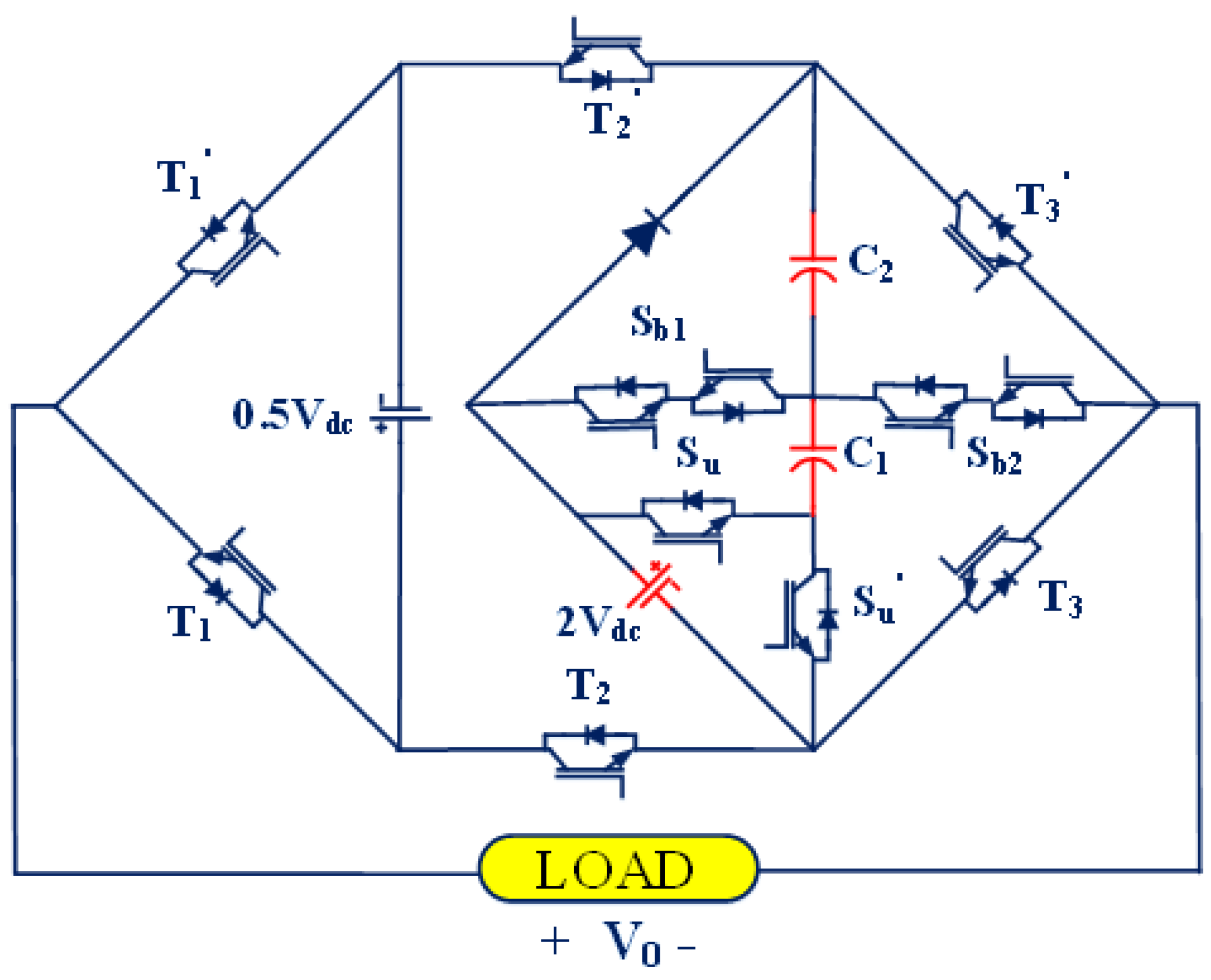
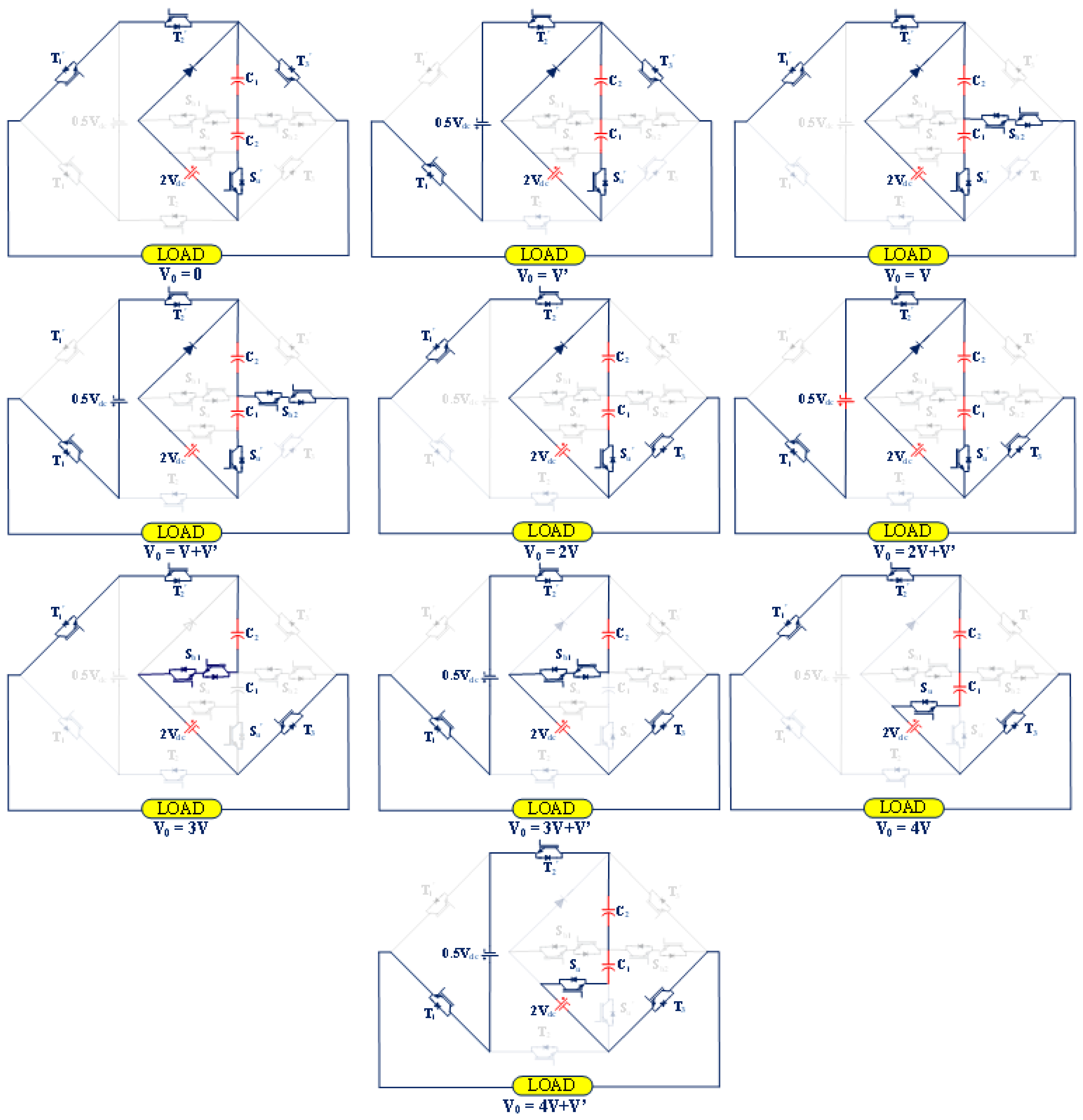


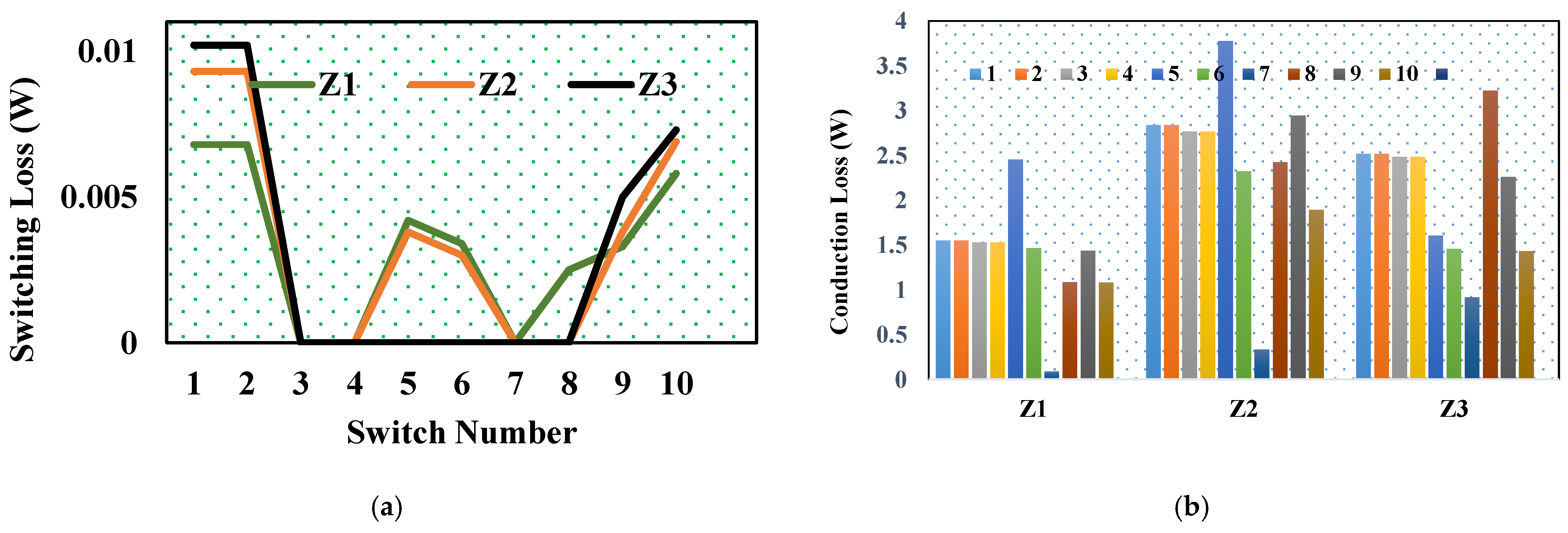

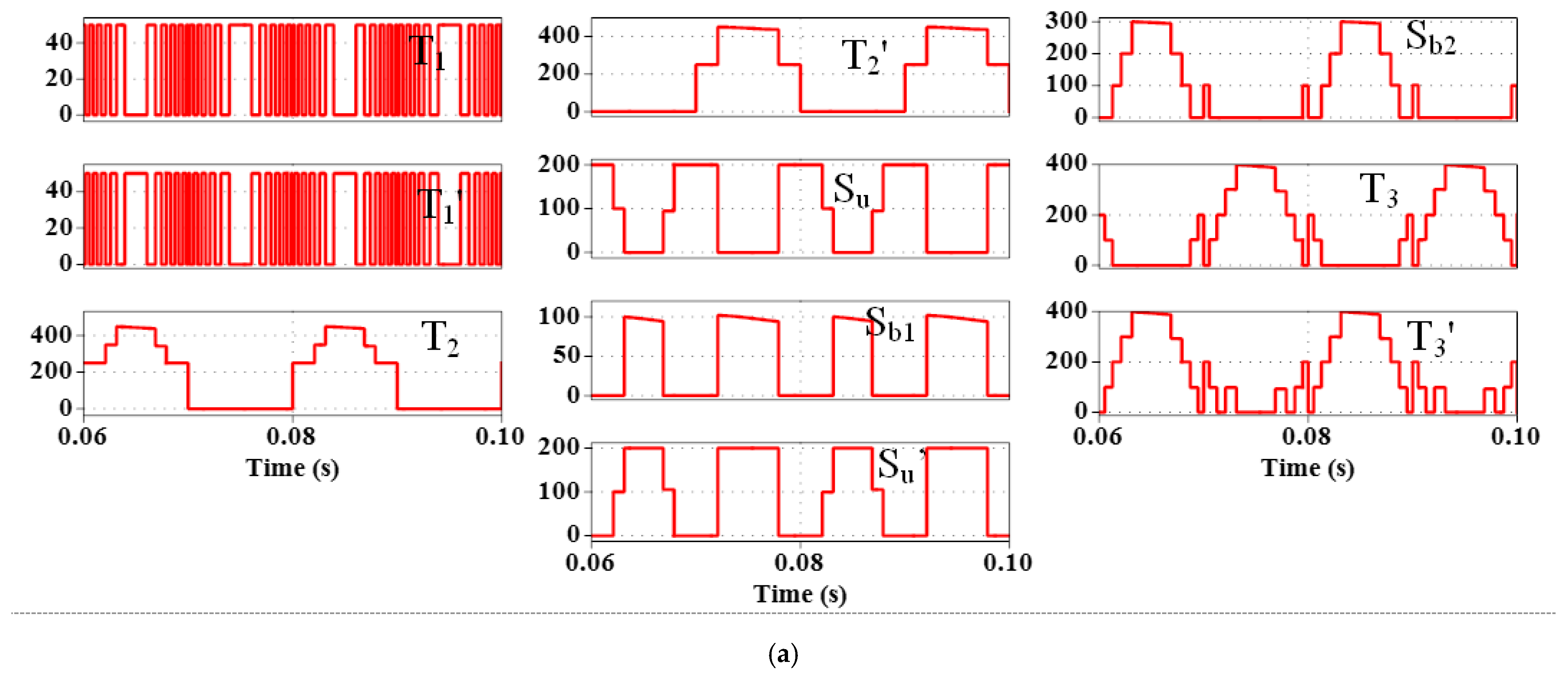
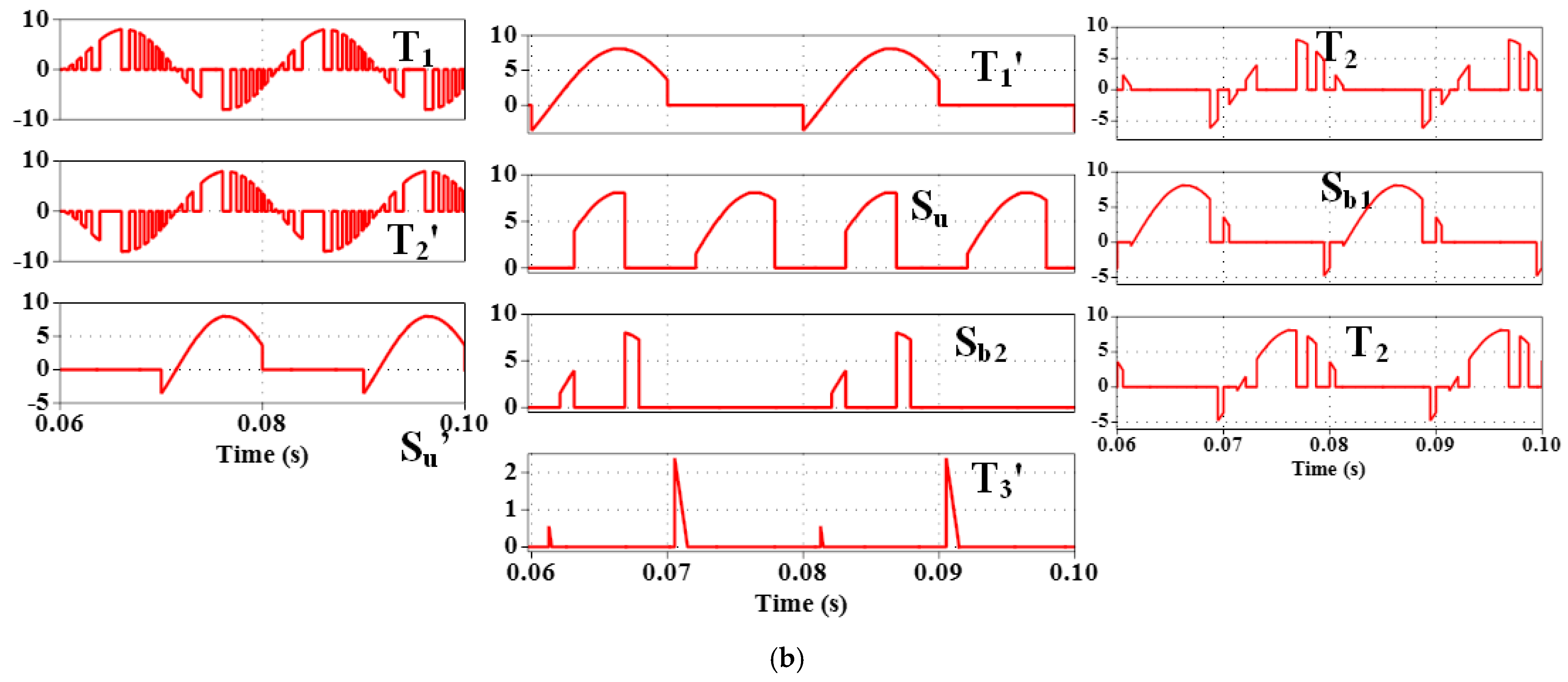
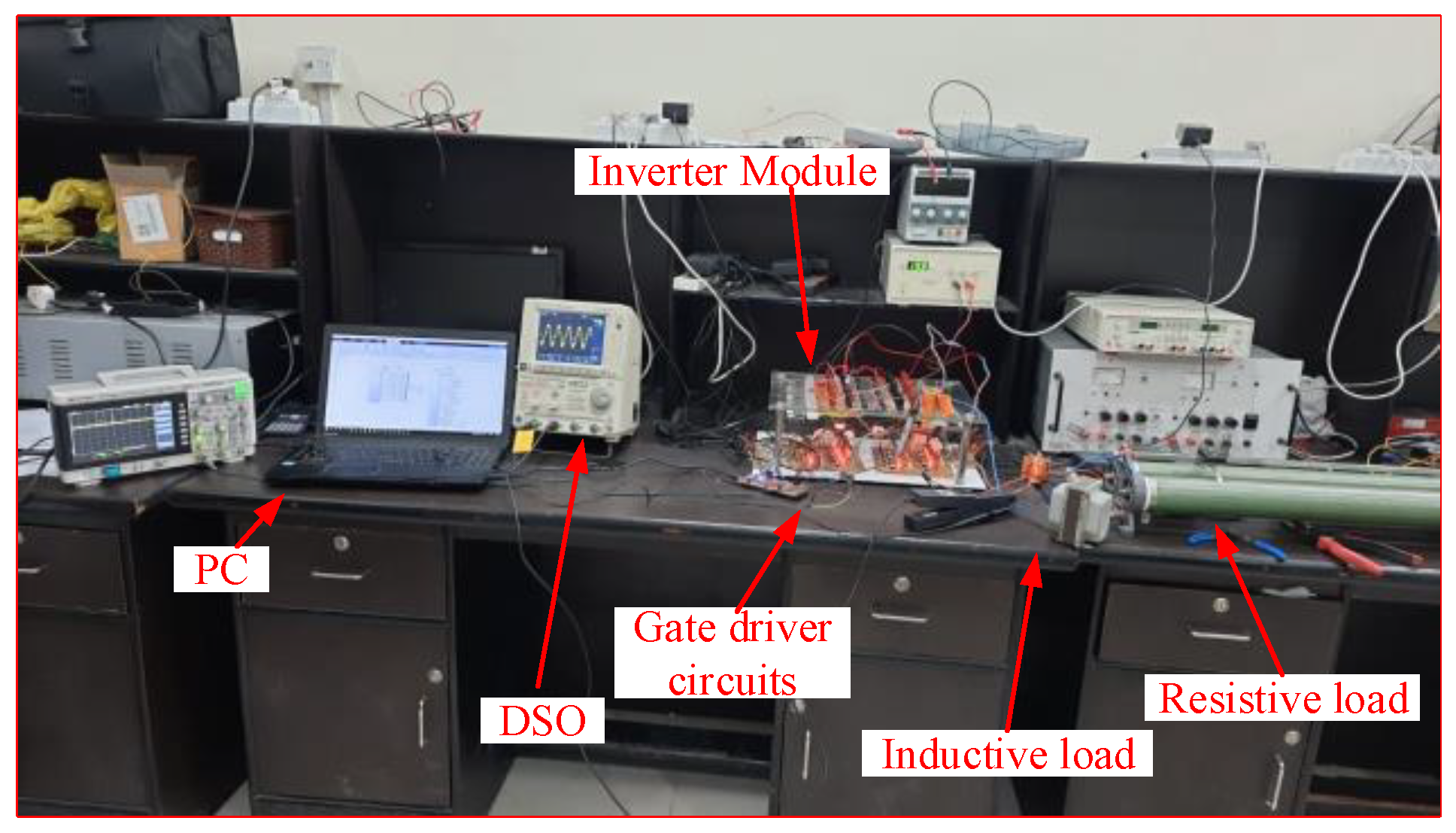

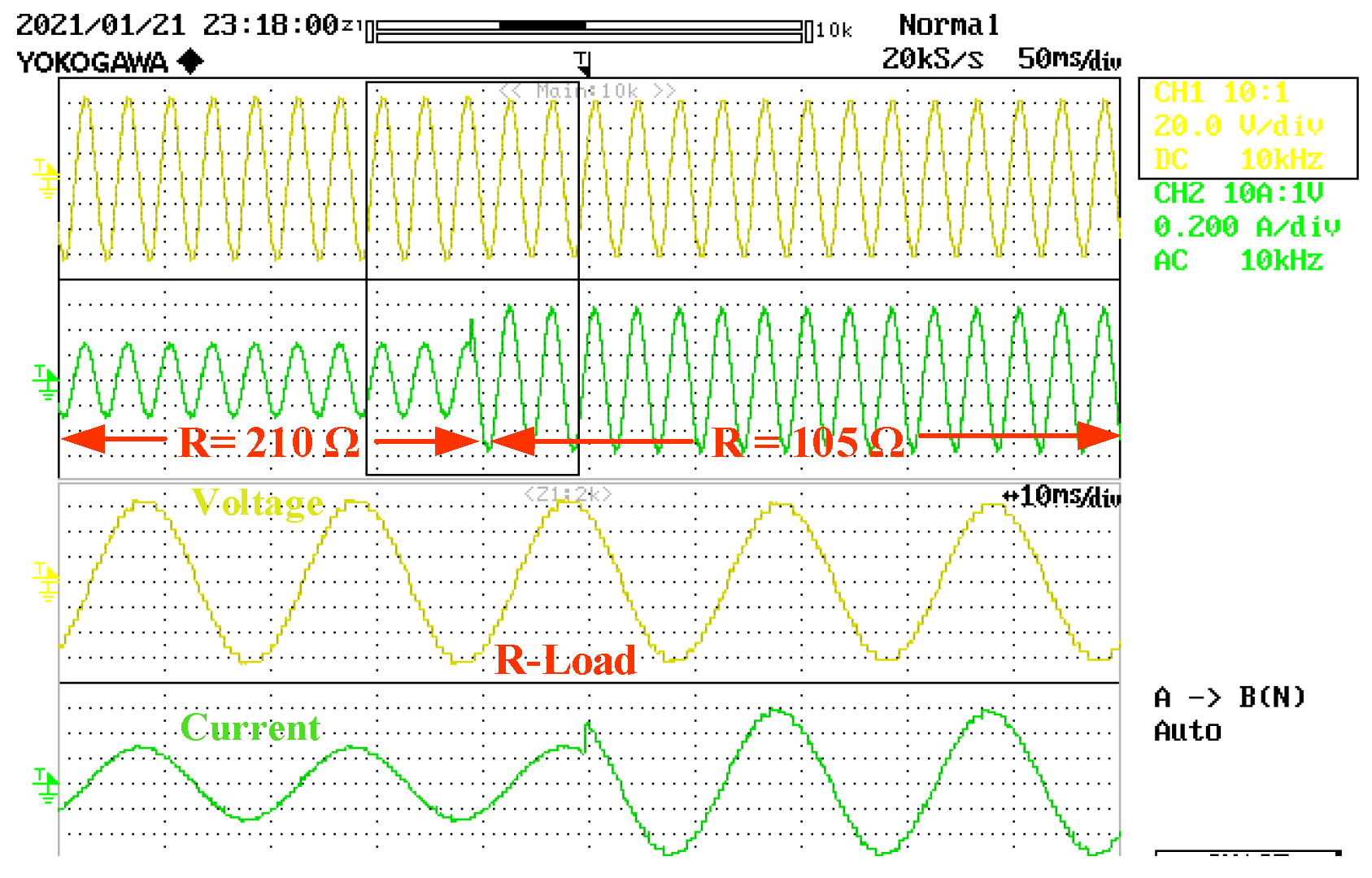

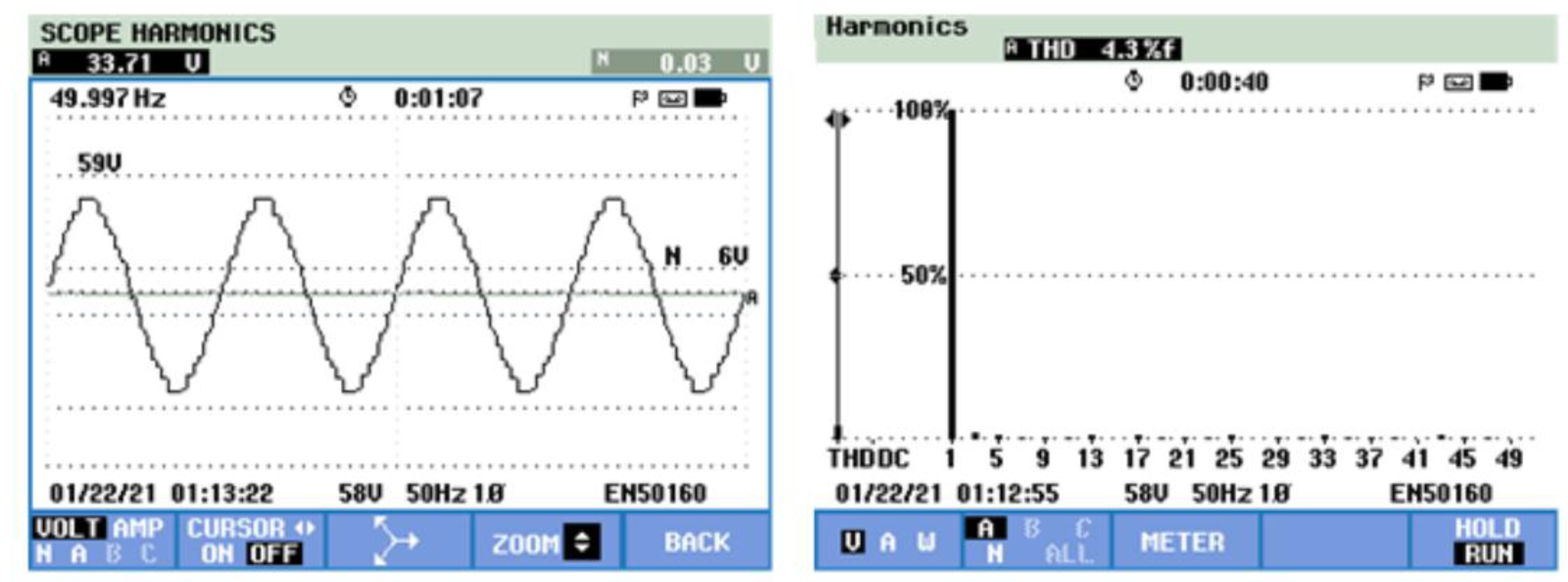
| T1 | T1’ | T2 | T2’ | Su | Sb1 | Su’ | Sb2 | T3 | T3’ | Vo | C1 | C2 |
|---|---|---|---|---|---|---|---|---|---|---|---|---|
| 0 | 1 | 0 | 1 | 0 | 0 | 1 | 0 | 0 | 1 | zero | C | C |
| 1 | 0 | 0 | 1 | 0 | 0 | 1 | 0 | 0 | 1 | 0.5 Vdc | C | C |
| 0 | 1 | 0 | 1 | 0 | 0 | 1 | 1 | 0 | 0 | Vdc | C | C |
| 1 | 0 | 0 | 1 | 0 | 0 | 1 | 1 | 0 | 0 | 1.5 Vdc | C | C |
| 0 | 1 | 0 | 1 | 0 | 0 | 1 | 0 | 1 | 0 | 2 Vdc | C | C |
| 1 | 0 | 0 | 1 | 0 | 0 | 1 | 0 | 1 | 0 | 2.5 Vdc | C | C |
| 0 | 1 | 0 | 1 | 0 | 1 | 0 | 0 | 1 | 0 | 3 Vdc | - | D |
| 1 | 0 | 0 | 1 | 0 | 1 | 0 | 0 | 1 | 0 | 3.5 Vdc | - | D |
| 0 | 1 | 0 | 1 | 1 | 0 | 0 | 0 | 1 | 0 | 4 Vdc | D | D |
| 1 | 0 | 0 | 1 | 1 | 0 | 0 | 0 | 1 | 0 | 4.5 Vdc | D | D |
| 1 | 0 | 1 | 0 | 0 | 0 | 1 | 0 | 1 | 0 | zero | C | C |
| 0 | 1 | 1 | 0 | 0 | 0 | 1 | 0 | 1 | 0 | −0.5 Vdc | C | C |
| 1 | 0 | 1 | 0 | 0 | 0 | 1 | 1 | 0 | 0 | −Vdc | C | C |
| 0 | 1 | 1 | 0 | 0 | 0 | 1 | 1 | 0 | 0 | −1.5 Vdc | C | C |
| 1 | 0 | 1 | 0 | 0 | 0 | 1 | 0 | 0 | 1 | −2 Vdc | C | C |
| 0 | 1 | 1 | 0 | 0 | 0 | 1 | 0 | 0 | 1 | −2.5 Vdc | C | C |
| 1 | 0 | 1 | 0 | 1 | 0 | 0 | 1 | 0 | 0 | −3 Vdc | D | − |
| 0 | 1 | 1 | 0 | 1 | 0 | 0 | 1 | 0 | 0 | −3.5 Vdc | D | − |
| 1 | 0 | 1 | 0 | 1 | 0 | 0 | 0 | 0 | 1 | −4 Vdc | D | D |
| 0 | 1 | 1 | 0 | 1 | 0 | 0 | 0 | 0 | 1 | −4.5 Vdc | D | D |
Publisher’s Note: MDPI stays neutral with regard to jurisdictional claims in published maps and institutional affiliations. |
© 2021 by the authors. Licensee MDPI, Basel, Switzerland. This article is an open access article distributed under the terms and conditions of the Creative Commons Attribution (CC BY) license (https://creativecommons.org/licenses/by/4.0/).
Share and Cite
Fahad, M.; Tariq, M.; Faizan, M.; Ali, A.; Sarwar, A.; Dehghani Tafti, H.; Ahmad, S.; Shah Noor Mohamed, A. A Dual Source Switched-Capacitor Multilevel Inverter with Reduced Device Count. Electronics 2022, 11, 67. https://doi.org/10.3390/electronics11010067
Fahad M, Tariq M, Faizan M, Ali A, Sarwar A, Dehghani Tafti H, Ahmad S, Shah Noor Mohamed A. A Dual Source Switched-Capacitor Multilevel Inverter with Reduced Device Count. Electronics. 2022; 11(1):67. https://doi.org/10.3390/electronics11010067
Chicago/Turabian StyleFahad, Mohammad, Mohd Tariq, Mohammad Faizan, Atib Ali, Adil Sarwar, Hossein Dehghani Tafti, Shafiq Ahmad, and Adamali Shah Noor Mohamed. 2022. "A Dual Source Switched-Capacitor Multilevel Inverter with Reduced Device Count" Electronics 11, no. 1: 67. https://doi.org/10.3390/electronics11010067






